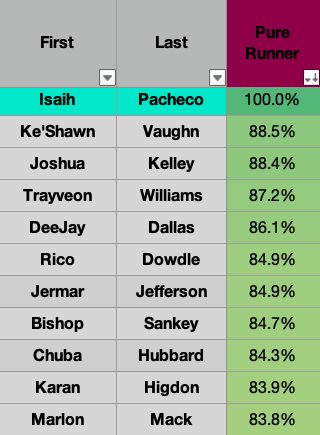Rutgers’ Isaih Pacheco is the next subject in a series in which I evaluate 2022 rookie running backs solely on their ability to run the ball. The Breakout Finder installments can be found here. The PlayerProfiler installments can be found here. If you happened to already catch those and don’t need a refresher on my methodology, feel free to skip to the player-focused analysis.

Rutgers’ Isaih Pacheco had a reasonably productive college career considering the abysmal teams he was playing on. He broke out as a true sophomore with a 34.7-percent Dominator Rating. Which is an 89th-percentile mark among second-year players since the 2007 draft class. Given that under-the-radar production, Pacheco may be an interesting player in the late rounds of rookie drafts. This assuming his on-field performance is up to snuff.
The Metrics
On relatively low volume (he never had more than 170 carries in a season), Isaih Pacheco averaged 0.51 yards per carry more than teammates who averaged a collective 2.75-star rating as high school recruits. That YPC+ mark lands right in the 50th-percentile, and the pedigree of those teammates is in just the 29th-percentile. Given the carry volume he handled and that subpar surrounding talent, we would expect a running back in Pacheco’s circumstances to post a YPC+ of 0.59, so his 0.51 is a bit disappointing in historical context.
His 1.44-percent Chunk Rate+ is a bit better, landing in the 57th-percentile. He was similarly fine as an open-field runner. The 33.3-percent of his chunk gains that he converted into breakaway gains is a 62nd-percentile Breakaway Conversion Rate.
The above team-relative numbers are even more mediocre when considered in relation to the box counts he was running against. While facing fronts that were 0.01 defenders lighter than those his teammates ran into (46th-percentile), Pacheco was more efficient than other Rutgers backs. But not by much. His 108.1-percent Box-Adjusted Efficiency Rating is just a 29th-percentile mark. Considering those box counts, he was less consistent than his backfield mates on a play-to-play basis. His Relative Success Rate of -3.6-percent is in the 22nd-percentile.
Rushing Efficiency Score and Comps
I’ve been using two composite scores to generalize player performance in these various metrics. In the first one, which accounts for all the non-BAE metrics in addition to overall team quality, rushing volume, strength of opponent, and offensive line play, Isaih Pacheco earns a 50.9 out of 100. In the second, which is centered around the box count metrics, he earns a 29.1. While completely average on the surface, given how easy his path to efficiency should have been, Pacheco is plain unimpressive.
Using the same metrics that go into the first efficiency composite (as well as physical measurables), I’m able to generate similarity scores between current and past prospects as a way to find comps for players as pure runners. Assuming he runs 4.50 40-yard dash at a projected 5-10.5 and 214-pounds, the following are his closest matches:

Marlon Mack and Ke’Shawn Vaughn headline a festival of JAGs here. Considering Pacheco posted comparable efficiency numbers to these guys while facing lighter box counts than teammates with subpar talent, we probably shouldn’t have high expectations for him at the next level.
Last Word
Isaih Pacheco is just not that good at running the football. There’s no reason to spend a rookie pick on him. He was invited to the Combine for reasons beyond my comprehension. But I’m sure his turns to bench press and run the 40-yard dash will give scouts and personnel executives an opportunity to go the bathroom or grab a hot dog.


